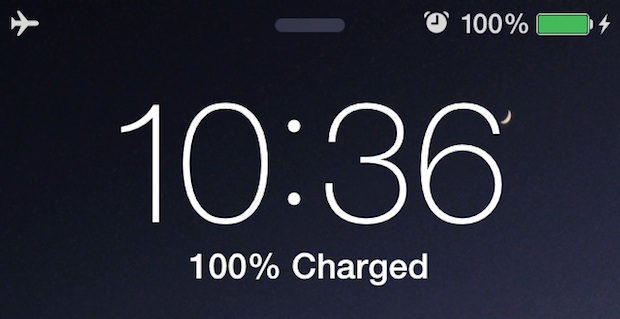

If you follow the general tech world through just about any medium, be it Twitter, Pinterest, or blogs, you may have seen a pretty bold battery charging claim gaining popularity lately, usually something along the lines of: “charge your iPhone twice as fast just by switching it into AirPlane Mode!” The theory behind that claim being that toggling AirPlane Mode on disables all communication radios and wireless transmitters in the device to make and receive calls, use cellular and wi-fi data, or have access to the GPS feature. It sounds great, maybe even reasonable since those things can drain the battery, plus switching airplane mode on is super easy, but does it actually work?
You’ll find plenty of iPhone and Android users who absolutely swear by the fast charging AirPlane Mode trick, but our own tests were much less convincing. In fact, after casually switching between the two charging options (airplane on, and airplane off as usual) over multiple charges, we couldn’t really notice a difference in charge time from various points of a drained battery. If there is an expedited charging speed that is offered through AirPlane Mode, it’s probably fairly minimal, maybe somewhere between 3-10 minutes for an iPhone 5, 5s, or 5c. Admittedly, this isn’t a scientific observation by any means (does anyone want to sit still and watch two iPhones charge side-by-side for 3 hours three different times? Probably not, let us know if you do), but presumably if the claim of charging “twice as fast” was actually true, you would certainly observe a difference almost immediately.
Considering the bold claims and widespread nature of the magical AirPlane charging recommendation, we dug a little deeper trying to find some technical details, perhaps the best of which came from a commenter on Lifehacker, who cited the power consumption and charge rate of the iPhone and charger itself, calling any potential benefit “marginal” at best, perhaps around 2%:
“Hmm, the benefit is marginal, at best. Considering the iPhone5’s 1,440 mAh battery capacity and stated 225 hour standby time, steady state power consumption is 6.4 mA. Factoring in inefficiencies, let’s round that up to 10 mA. If you use the included charger to charge at 500 mA, you’re talking about getting back just 2% of that charge rate. Even if you turn off the phone, the improvement is likely to be more psychological than practical. So, in other words, feel free to keep you phone on while charging. Now, playing a high-CPU-demand game on max screen brightness, that’s a slightly different matter. If power usage goes up to say 100 mA or more, you might actually notice an extension of charging time under those intensive conditions.”
Is turning on AirPlane Mode worth a 2% faster charge time over the course of a couple of hours while missing out on texts, phone calls, data, emails, and whatever else you use your phone for? You can decide that on your own.
So while we’re not convinced it’ll make much of a difference in how long it takes to charge your iPhone, if you do this regularly and have some data to back it up, let us know your own results.
By the way, if you do actually want to charge your iPhone as fast as possible, the best thing you can do is plug it into a wall outlet and not use the phone while it’s charging. Powering the bright backlit display and using heavy data usage does actually use power, so by not using either you can expedite the process a tad. From a 0% charge, the iPhone will usually be back to 100% in around 3 hours or less.


Aside from that, it’s usually best to focus on preserving battery by turning off unnecessary background activity, unused location services, and various eye-candy features. It works.
Follow Me:
Top Best Sellers!!





